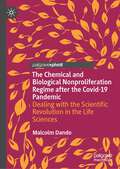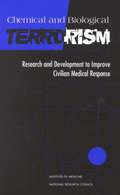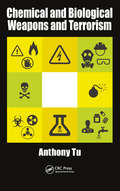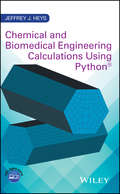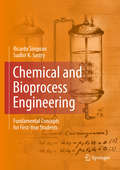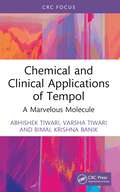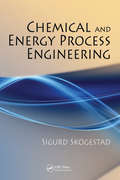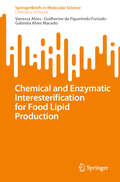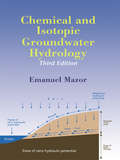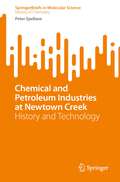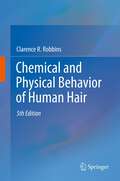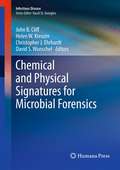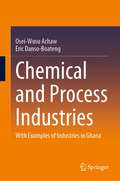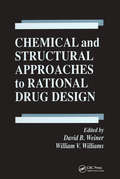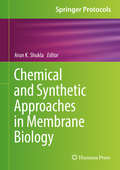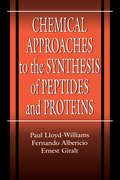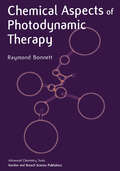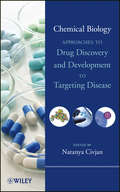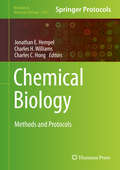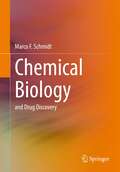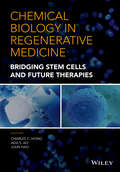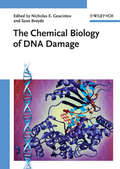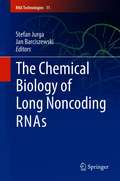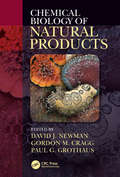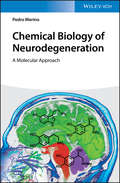- Table View
- List View
The Chemical and Biological Nonproliferation Regime after the Covid-19 Pandemic: Dealing with the Scientific Revolution in the Life Sciences
by Malcolm DandoThis book offers an analysis of how the Chemical and Biological Weapons (CBW) regime has responded in the immediate aftermath of the Covid-19 pandemic. Coronavirus has highlighted the need to better protect modern societies from natural, accidental and deliberate disease affecting humans, animals and plants. Within that context preventing the deliberate hostile use of biological and chemical agents will be of increasing importance. Dando asks to what extent there has been a significant strengthening to the CBW non-proliferation regime in the immediate aftermath of the COVID-19 pandemic using an analysis focused on two proposals to strengthen the Chemical Weapons Convention and the Biological and Toxin Weapons Convention which aim to constrain advances in science and technology developments that could be misused. On this basis he concludes that it would be hard to argue that to date there has been a significant strengthening of the CBW regime.
Chemical and Biological Terrorism: Research and Development to Improve Civilian Medical Response
by National Research CouncilThe threat of domestic terrorism today looms larger than ever. Bombings at the World Trade Center and Oklahoma City's Federal Building, as well as nerve gas attacks in Japan, have made it tragically obvious that American civilians must be ready for terrorist attacks. What do we need to know to help emergency and medical personnel prepare for these attacks? Chemical and Biological Terrorism identifies the R&D efforts needed to implement recommendations in key areas: pre-incident intelligence, detection and identification of chemical and biological agents, protective clothing and equipment, early recognition that a population has been covertly exposed to a pathogen, mass casualty decontamination and triage, use of vaccines and pharmaceuticals, and the psychological effects of terror. Specific objectives for computer software development are also identified. The book addresses the differences between a biological and chemical attack, the distinct challenges to the military and civilian medical communities, and other broader issues. This book will be of critical interest to anyone involved in civilian preparedness for terrorist attack: planners, administrators, responders, medical professionals, public health and emergency personnel, and technology designers and engineers.
Chemical and Biological Weapons and Terrorism
by Anthony TuWritten by the world’s leading expert on the Tokyo sarin attacks, Chemical and Biological Weapons and Terrorism is a comprehensive examination of the use, detection, and prevention of chemical and biological attacks. Divided in two parts, one devoted to chemical and the other biological weapons, this book emphasizes defense, decontamination, detection, treatment, mechanism of toxic action, and pathological effects in the case of each. Covering a diverse range of substances, chapters draw on detailed case studies on the US anthrax attacks, the Tokyo sarin gas attacks, as well as an entire chapter devoted to the Iran-Iraq War co-authored with Dr. Sayid Abbas Foroutan, a former Iranian military surgeon who actively participated in the treatment of Iranian soldiers suffering from gas poisoning. Features include: A case study of the Tokyo sarin gas attacks from the leading expert on the subject A detailed case study on the U.S. anthrax attacks A chapter on the Iran-Iraq War and controversial weapons co-authored with an Iranian military surgeon with first-hand knowledge of the subject Details on the various ways chemical and biological weapons can be constructed and deployed Applicable defense strategies, including detection of materials and decontamination in the event chemical/biological weapons are deployed Featuring over 100 unique photographs and detailed chemical structures, Chemical and Biological Weapons and Terrorism is essential reading for counterterrorism experts, first responders and medical professionals, security consultants and military personnel seeking to expand their knowledge of preventative strategies. The book also will serve as a great resource for students in homeland security, public administration, and criminal justice programs.
Chemical and Biomedical Engineering Calculations Using Python
by Jeffrey J. HeysPresents standard numerical approaches for solving common mathematical problems in engineering using Python. Covers the most common numerical calculations used by engineering students Covers Numerical Differentiation and Integration, Initial Value Problems, Boundary Value Problems, and Partial Differential Equations Focuses on open ended, real world problems that require students to write a short report/memo as part of the solution process Includes an electronic download of the Python codes presented in the book
Chemical and Bioprocess Engineering: Fundamental Concepts for First-Year Students
by Ricardo Simpson Sudhir K. SastryThe goal of this textbook is to provide first-year engineering students with a firm grounding in the fundamentals of chemical and bioprocess engineering. However, instead of being a general overview of the two topics, Fundamentals of Chemical and Bioprocess Engineering will identify and focus on specific areas in which attaining a solid competency is desired. This strategy is the direct result of studies showing that broad-based courses at the freshman level often leave students grappling with a lot of material, which results in a low rate of retention. Specifically, strong emphasis will be placed on the topic of material balances, with the intent that students exiting a course based upon this textbook will be significantly higher on Bloom's Taxonomy (knowledge, comprehension, application, analysis and synthesis, evaluation, creation) relating to material balances. In addition, this book will also provide students with a highly developed ability to analyze problems from the material balances perspective, which will leave them with important skills for the future. The textbook will consist of numerous exercises and their solutions. Problems will be classified by their level of difficulty. Each chapter will have references and selected web pages to vividly illustrate each example. In addition, to engage students and increase their comprehension and rate of retention, many examples will involve real-world situations.
Chemical and Clinical Applications of Tempol: A Marvelous Molecule
by Abhishek Tiwari Varsha Tiwari Bimal Krishna BanikA comprehensive and authoritative exploration of Tempol (4-Hydroxy-TEMPO), an exceptional chemical compound with diverse applications in both scientific research and medical practice. This book delves into Tempol's unique properties, mechanisms of action, and its potential role in combating oxidative stress-related disorders. Includes a chapter devoted to the safe handling, storage, and disposal of Tempol in compliance with pharmaceutical regulations. The authors pay particular attention to pharmaceutical regulations in the industry.
Chemical and Energy Process Engineering
by Sigurd SkogestadEmphasizing basic mass and energy balance principles, Chemical and Energy Process Engineering prepares the next generation of process engineers through an exemplary survey of energy process engineering, basic thermodynamics, and the analysis of energy efficiency. By emphasizing the laws of thermodynamics and the law of mass/matter conservation, the
Chemical and Enzymatic Interesterification for Food Lipid Production (SpringerBriefs in Molecular Science)
by Vanessa Alves Guilherme de Furtado Gabriela Alves MacedoThis book addresses special lipids produced by chemical and enzymatic interesterification and explores the interesterification process and its crucial role in the modification of oils for various applications. The book discusses the chemical and enzymatic aspects of this process, providing an in-depth understanding of its mechanism, benefits, and limitations. The book covers key concepts such as the mechanism of interesterification, the use of immobilized lipases in enzymatic interesterification, and current applications of interesterification in fats and oils. Particular attention is given to acidolysis, alcoholysis, glycerolysis, and transesterification - the four types of interesterification reactions, and to the advantages and drawbacks of both enzymatic and chemical interesterification. In this book, the authors address critical questions like the fate of fatty acids from interesterified lipids after consumption and their long-term health effects. Readers will also learn more about the current applications of interesterification in fats and oils, including special lipids like plastic fats, human milk fat substitutes, structured lipids enriched with essential fatty acids, cocoa butter equivalents and substitutes, and low-calorie structured lipids. Aimed at researchers and professionals in food science, this book offers valuable insights into the production of various specialty fats through enzymatic interesterification, thereby equipping readers with the knowledge to innovate in the field of food applications. Readers with a background in food chemistry will benefit from its detailed explanation of lipase-catalyzed synthesis and the use of alkali metals in interesterification.
Chemical and Isotopic Groundwater Hydrology (Books In Soils, Plants, And The Environment Ser. #Vol. 98)
by Emanuel MazorThis updated and expanded edition provides a thorough understanding of the measurable properties of groundwater systems and the knowledge to apply hydrochemical, geological, isotopic, and dating approaches to their work. This volume includes question and answer discussions for key concepts presented in the text and the basic hydrological, geological, and physical parameters to be observed and measured. Chemical and Isotopic Groundwater Hydrology, Third Edition covers the chemical tools of groundwater hydrology, the isotopic composition of water and groundwater dating by tritum, carbon-14, Cl-36, and He-4, as well as the application of fossil groundwater as a paleoclimatic indicator.
Chemical and Petroleum Industries at Newtown Creek: History and Technology (SpringerBriefs in Molecular Science)
by Peter SpellaneThis book constructs a history of Newtown Creek’s industrial expansion during the period that began in the 1840s and continued through the early years of the 20th century. In that period, the production of reagent chemicals and refined materials near the center of modern-day New York City grew steadily, as practitioners, alert to European advances in chemical science, developed and applied increasingly sophisticated technologies. Innovations in methods of production, ready access to domestic and international markets, and sustained growth in volumes of production at Newtown Creek in the late 19th century had profound consequences for the practice of industrial chemistry in the United States and for the economic vitality of the City of New York. Industrial practice progressed from the recovery of animal tissues to the refining of crude petroleum and the production of high-purity copper and other metals from mineral ores. With attention to each company’s technical expertise and principal products, this book examines the interdependence of the chemicals- and materials-producing industries that thrived along Newtown Creek’s shores. The author recounts Newtown Creek’s industrial history alongside the stories of well-known New Yorkers – Peter Cooper, Charles Pratt, John D. and William Rockefeller – and other less celebrated or less notorious characters. This book provides a valuable account of New York’s history in the manufacture of reagent chemicals and refined fuels and metals and will appeal to researchers, scholars and historians interested in the early years of industrial chemistry.
Chemical and Physical Behavior of Human Hair
by Clarence R. RobbinsHuman hair is the subject of a remarkably wide range of scientific investigations. Its chemical and physical properties are of importance to the cosmetics industry, forensic scientists and to biomedical researchers. The fifth edition of this book confirms its position as the definitive monograph on the subject. Previous editions were recognized as "concise and thorough" (Journal of the American Chemical Society), "an invaluable resource" (Canadian Forensic Science Society Journal), and "highly recommended" (Textile Research Journal). Chemical and Physical Behavior of Human Hair is a teaching guide and reference volume for cosmetic chemists and other scientists in the hair products industry, academic researchers studying hair and hair growth, textile scientists and forensic specialists. Features of the Fifth Edition: Recent advances in the classification and characterization of the different proteins and genes in IF and keratin associated proteins in human hair are described. The mechanism and incidence of hair growth and loss and hair density vs. age of males & females are described for Asians, Caucasians and Africans in different scalp regions. Details of hair surface lipids and cuticle membranes provide a better understanding of the surface and organization of the CMC and its involvement in stress strain is presented. Recent evidence demonstrates a more bilateral structure in curly hair and a more concentric arrangement of different cortical proteins in straighter hair. SNPs involved in hair form (curl and coarseness) and pigmentation and genes in alopecia and hair abnormalities are described. The latest biosynthetic scheme for hair pigments and structures for these and the different response of red versus brown-black pigments to photodegradation is described.A new method for curvature on 2,400 persons from different countries and groups is used to assign curvature throughout this book. Additional data for age and effects on diameter, ellipticity, elastic modulus, break stress and other parameters are presented with much larger data sets featuring statistical analyses. Hair conditioning, strength, breakage, split ends, flyaway, shine, combing ease, body, style retention, manageability and feel parameters are defined and described. A new section of different life stages by age groups considering collective and individual changes in hair fiber properties with age and how these affect assembly properties.
Chemical and Physical Signatures for Microbial Forensics (Infectious Disease)
by Helen W. Kreuzer David S. Wunschel John B. Cliff Christopher J. EhrhardtCombining the disciplines of biological, physical and chemical science, microbial forensics has a rapidly rising profile in a world increasingly troubled by the threat of 'biocrime' and 'bioterrorism'. This valuable resource is a major addition to a body of literature reckoned to lack sufficient breadth. It presents a variety of phenotypic and trace signature methodologies associated with cultured microorganisms that, despite being genetically identical, may be characterized by differing cultural environments. One of the central challenges faced by those working in this field is the sheer diversity of potentially harmful agents, which in themselves total more than 1000 viruses, bacteria, fungi and protozoan parasites. Their numerous additional variants render the process of 'fingerprinting' biological agents notoriously difficult, especially when the limitations of genetic analysis are factored in. Attribution of crime is relatively easy through human DNA, but lacking the genetic individuation of humans and animals, microbial forensics has to complement phylogenetic techniques with chemical and physical ones. In the best case, genetic analysis in the 'biocrime' sector can exclude sources, narrow the population of possible sources and support associations with potential sources. To complement these genetic techniques, chemical and physical methods can be used to compare 'signatures' imparted to microbial samples by environments in which they are grown and processed. Collating a range of microbiological fingerprinting techniques in one volume, and covering everything from statistical analysis to laboratory protocols, this publication furthers the aim of forensic investigators who need robust and legally admissible forensic evidence to present in a courtroom.
Chemical and Process Industries: With Examples of Industries in Ghana
by Osei-Wusu Achaw Eric Danso-BoatengThis textbook presents a thorough overview of chemical and process industries. It describes the standard technologies and the state of the industries and the manufacturing processes of specific chemical and allied products. It includes examples of industries in Ghana, highlighting the real-world applications of these technologies.The book introduces new developments in the processes in chemical industry, focuses on the technology and methodology of the processes and the chemistry underlying them. It offers guidance on operating of processing units. Furthermore, it includes sections on safety and environmental pollution control in industry.With a pedagogical and comprehensive approach, utilizing illustrations and tables, this book provides students in chemical engineering and industrial chemistry with a concise and up-to-date overview of this diverse subject.
Chemical and Structural Approaches to Rational Drug Design (Handbooks In Pharmacology And Toxicology Ser. #14)
by David B. Weiner; William B. WilliamsThis book is the first to provide both a broad overview of the current methodologies being applied to drug design and in-depth analyses of progress in specific fields. It details state-of-the-art approaches to pharmaceutical development currently used by some of the world's foremost laboratories. The book features contributors from a variety of fields, new techniques, previously unpublished data, and extensive reference lists.
Chemical and Synthetic Approaches in Membrane Biology (Springer Protocols Handbooks)
by Arun K. ShuklaThis practical volume brings together a broad range of topics related to membrane biology research with particular emphasis on novel approaches, technology platforms, and emerging tools in this area of study. Beginning with chapters pertaining to artificial or designer membrane mimetics that can be utilized for in vitro studies of membrane-lipid interactions, it then continues by covering the approaches and methodologies to directly investigate membrane protein structure, localization, and dynamics. Written for the Springer Protocols Handbooks series, this collection focuses on in-depth, hands-on protocols from experts in the field. Authoritative and cutting-edge, Chemical and Synthetic Approaches in Membrane Biology serves as an ideal guide to researchers investigating the vital properties of cellular membranes.
Chemical Approaches to the Synthesis of Peptides and Proteins (New Directions In Organic And Biological Chemistry Ser. #10)
by Ernest Giralt Fernando Albericio Paul Lloyd-WilliamsOrganic chemists working on the synthesis of natural products have long found a special challenge in the preparation of peptides and proteins. However, more reliable, more efficient synthetic preparation methods have been developed in recent years. This reference evaluates the most important synthesis methods available today, and also considers methods that show promise for future applications.This text describes the state of the art in efficient synthetic methods for the synthesis of both natural and artificial large peptide and protein molecules. Subjects include an introduction to basic topics, linear solid-phase synthesis of peptides, peptide synthesis in solution, convergent solid-phase synthesis, methods for the synthesis of branched peptides, formation of disulfide bridges, and more. The book emphasizes strategies and tactics that must be considered for the successful synthesis of peptides.
Chemical Aspects of Photodynamic Therapy
by Raymond BonnettPhotodynamic therapy (PDT) is a ground breaking medical technique which uses lasers to activate light-sensitive chemicals to treat cancer and other diseases without resorting to surgery. For the first time, Chemical Aspects of Photodynamic Therapy introduces in an accessible way the physics, chemistry and biology behind the technique. This highly a
Chemical Biology: Approaches to Drug Discovery and Development to Targeting Disease
by Natanya CivjanAn authoritative look at the application of chemical biology in drug discovery and development Based on the award-winning Wiley Encyclopedia of Chemical Biology published in 2008, this book explores the role of chemical biology in drug discovery and development. The first part of the book reviews key principles and techniques used in the design and evaluation of drug candidates. The second part elucidates biological mechanisms of certain diseases, illuminating approaches to investigate and target these diseases. Comprising carefully selected reprints from the Encyclopedia as well as new contributions from leading scholars in the field, this book provides researchers in academia and industry with important information to aid in the development of novel agents to treat disease. Self-contained articles cover a variety of essential topics, including: The design, development, and optimization of drug candidates The pharmacokinetics and properties of drugs Drug transport and delivery Natural products and natural product models as pharmaceuticals Biological mechanisms underlying health and disease Treatment strategies for a range of diseases, from HIV to schizophrenia Chemical Biology is a top-notch guide and reference for anyone working in the areas of drug discovery and development, including researchers in chemical biology and other fields such as biochemistry, medicine, and pharmaceutical sciences.
Chemical Biology: Methods and Protocols (Methods in Molecular Biology #1263)
by Charles C. Hong Jonathan E. Hempel Charles H. WilliamsThis volume seeks to enable the discovery of tools in chemical biology by providing readers with various techniques ranging from initial chemical genetic screening to target identification. To successfully highlight the essential components of the chemical biology tool discovery process, the book is organizes into four parts that focus on platforms for molecular discovery in in vitro cellular systems, in vivo chemical genetic screening protocols, and methods used to discover functional protein targets. Written in the highly successful Methods of Molecular Biology series format, chapters include introductions to their respective topics, lists of the necessary materials and reagents, step-by-step readily reproducible laboratory protocols, and key tips on troubleshooting and avoiding known pitfalls. Practical and informative, Chemical Biology: Methods and Protocols seeks to improve the success rate of the chemical biology field through the dissemination of detailed and experiential knowledge.
Chemical Biology: and Drug Discovery
by Marco F. SchmidtThe focus of this textbook is on application, rather than pure knowledge transfer of the results of all chemical biological work (which would also be beyond the scope of a book). It gives the reader, through the specific selection of chemical biological techniques and concepts, the necessary tools to be able to develop new ways of thinking and thus new therapeutic options in the complex field of chemical biology and drug development. The stated aim of this book is to provide concrete solutions and inspiration to students, (post)graduate students, and experienced scientists at universities as well as in industry in their problems. After an introduction to the problems addressed by chemical biology in drug discovery, the three levels of molecular biology dogma: DNA, RNA and proteins and their role as drug targets serve as the common thread of this book.This book is a translation of the original German 1st edition Chemische Biologie by Marco F. Schmidt, published by Springer-Verlag GmbH Germany, part of Springer Nature in 2020. The translation was done with the help of artificial intelligence (machine translation by the service DeepL.com). A subsequent human revision was done primarily in terms of content, so that the book will read stylistically differently from a conventional translation. Springer Nature works continuously to further the development of tools for the production of books and on the related technologies to support the authors.
Chemical Biology in Regenerative Medicine
by Charles C. Hong Jijun Hao Ada S. AoChemical Biology in Regenerative Medicine: Bridging Stem Cells and Future Therapies The field of regenerative medicine has advanced at a rapid pace and this comprehensive summary of new developments is a timely contribution to the field as clinical trials have begun to assess the safety and efficacy of cell-based therapies. In Chemical Biology in Regenerative Medicine, an international team of experts provides an overview of progress towards clinical application in the areas of transplantation (allogenic and autologous), manipulation of niche environment and homing, and cell reprogramming (trans-differentiation and de-differentiation). The book highlights the interdisciplinary approaches undertaken to resolve current technical problems in regenerative medicine, with special attention paid to small molecules and biomaterials engineering. This volume provides an essential overview of this emerging technology for researchers in academic, industrial and clinical environments working in regenerative medicine, chemical biology, biochemistry, cell biology, biomaterials and bioengineering. It is appropriate for training students and newcomers to the field, benefitting readers in broadening their knowledge and giving them insights to regenerative chemical biology, as well as encouraging readers to implement the key points in their own fields of study to develop new technologies.
The Chemical Biology of DNA Damage
by Nicholas E. Geacintov Suse BroydeBringing the power of biochemical analysis to toxicology, this modern reference explains genotoxicity at the molecular level, showing the links between a DNA lesion and the resulting cellular or organismic response. Clearly divided into two main sections, Part 1 focuses on selected examples of important DNA lesions and their biological impact, while the second part covers current advances in assessing and predicting the genotoxic effects of chemicals, taking into account the biological responses mediated by the DNA repair, replication and transcription machineries. A ready reference for biochemists, toxicologists, molecular and cell biologists, and geneticists seeking a better understanding of the impact of chemicals on human health.
The Chemical Biology of Long Noncoding RNAs (RNA Technologies #11)
by Jan Barciszewski Stefan JurgaThis book offers a comprehensive and detailed overview of various aspects of long non-coding RNAs. It discusses their emerging significance in molecular medicine, ranging from human cancers to cardiovascular and metabolic diseases. Transcriptomic studies have demonstrated that the majority of genomes found in complex organisms are expressed in highly dynamic and cell-specific patterns, producing huge numbers of intergenic, antisense and intronic long non-protein-coding RNAs (lncRNAs). Thousands of lncRNAs have been identified, and unlike mRNA, they have no protein-coding capacity. A large repertoire of ncRNAs, actively transcribed from the mammalian genome, control diverse cellular processes, both in terms of development and diseases, through a variety of gene regulatory mechanisms. IncRNAs have emerged as a new paradigm in epigenetic regulation of the genome. Given its scope, the book will be of particular interest to molecular, chemical, cell and developmental biologists, as well as specialists in translational medicine involved in disease-oriented research. It also offers a valuable resource for in silico experts seeking a deeper understanding of lncRNA expression and function through computational analysis of the NGS data.
Chemical Biology of Natural Products
by David Newman Gordon Cragg Paul GrothausChemical Biology of Natural Products This unique, long-awaited volume is designed to address contemporary aspects of natural product chemistry and its influence on biological systems, not solely on human interactions. The subjects covered include discovery, isolation and characterization, biosynthesis, biosynthetic engineering, pharmaceutical, and other applications of these compounds. Each chapter begins with a brief and simple introduction to the subject matter, and then proceeds to guide the reader towards the more contemporary, cutting-edge research in the field, with the contributing authors presenting current examples from their own work in order to exemplify key themes. Topics covered in the text include genome mining, heterologous expression, natural product synthesis, biosynthesis, glycosylation, chemical ecology, and therapeutic applications of natural products, both current and potential.
Chemical Biology of Neurodegeneration: A Molecular Approach
by Pedro MerinoChemical Biology of Neurodegeneration
